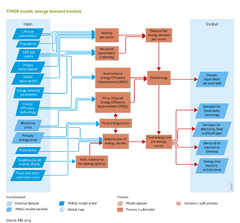Energy demand/Description: Difference between revisions
Jump to navigation
Jump to search
Edelenbosco (talk | contribs) No edit summary |
Edelenbosco (talk | contribs) No edit summary |
||
| Line 53: | Line 53: | ||
The efficiency changes in both passenger and freight transport represent the autonomous increase in energy efficiency, and the price-induced improvements in energy efficiency improvement parameters. These changes are described by substitution processes in explicit technologies, such as vehicles with different energy efficiencies, costs and fuel type characteristics compete on the basis of preferences and total passenger-kilometre costs, using a multinomial logit equation. The efficiency of the transport fleet is determined by a weighted average of the full fleet (a vintage model, giving an explicit description of the efficiency in all single years). As each type of vehicle is assumed to use only one fuel type, this process also describes the fuel selection. | The efficiency changes in both passenger and freight transport represent the autonomous increase in energy efficiency, and the price-induced improvements in energy efficiency improvement parameters. These changes are described by substitution processes in explicit technologies, such as vehicles with different energy efficiencies, costs and fuel type characteristics compete on the basis of preferences and total passenger-kilometre costs, using a multinomial logit equation. The efficiency of the transport fleet is determined by a weighted average of the full fleet (a vintage model, giving an explicit description of the efficiency in all single years). As each type of vehicle is assumed to use only one fuel type, this process also describes the fuel selection. | ||
<div class= | <div class="version changev31"> | ||
Since Girod et. al ([[Girod et al., 2012|2012]]) the LDV projected vehicle costs and efficiency have been revised to incorporate the most recent projections of LDV vehicle technology development. The vehicle characteristics are based on the in depth study performed by the Argonne National Laboratory ([[Plotkin and Singh 2009|2009]]). | Since Girod et. al ([[Girod et al., 2012|2012]]) the LDV projected vehicle costs and efficiency have been revised to incorporate the most recent projections of LDV vehicle technology development. The vehicle characteristics are based on the in depth study performed by the Argonne National Laboratory ([[Plotkin and Singh 2009|2009]]). | ||
</div> | </div> | ||
Revision as of 15:17, 4 November 2016
Parts of Energy demand/Description
| Component is implemented in: |
|
| Related IMAGE components |
| Projects/Applications |
| Key publications |
| References |
